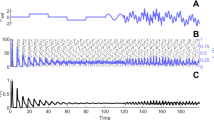Abstract
Activity-dependent slow biochemical regulation processes, affecting intrinsic properties of a neuron, might play an important role in determining information processing strategies in the nervous system. We introduce second-order biochemical phenomena into a linear leaky integrate-and-fire model neuron together with a detailed kinetic description for synaptic signal transduction. In this framework, we investigate the membrane intrinsic electrical properties differentiation, showing the appearance of activity-dependent shifts between integration and temporal coincidence detection operating mode, for the single unit of a network.
Similar content being viewed by others
References
Abbott LF, Kepler TB (1990) Model neurons: From Hodgkin-Huxley to Hopfield. In: Garrido L, ed. Statistical Mechanics of Neural Networks. Springer Verlag, Barcelona. pp. 5–18.
Abbott LF, LeMasson G (1993) Analysis of neuron models with dynamically regulated conductances. Neural Comput. 5, 823–842.
Bernander O, Douglas RJ, Martin KAC, Koch C (1991) Synaptic background activity influences spatiotemporal integration in single piramidal cells. Proc. Natl. Acad. Sci. 88, 11569–11573.
Bialek W, Rieke F, Vansteveninck RRD, Warland D (1991) Reading a neural code. Science 252, 1854–1857.
Cash S, Yuste R (1998) Input summation by cultured pyramidal neurons is linear and position-independent. J. Neurosci. 18, 10–15.
Chapeau-Blondeau F, Chambet N (1995) Synapse models for neural networks: From ion channel kinetics to multiplicative coefficient w ij. Neural Comput. 7, 713–734.
Destexhe A, Mainen ZF, Sejnowski TJ (1994) An efficient method for computing synaptic conductances based on a kinetic model of receptor binding. Neural Comput. 6, 14–18.
Fries P, Roelfsema PR, Engel AK, Koenig P, Singer W (1997) Synchronization of oscillatory responsed in visual cortex correlates with perception in interocular rivalry. Proc. Natl. Acad. Sci. 94, 12699–12704.
Herz J, Krogh A, Palmer RG (1990) Introduction to the Theory of Neural Computation. Addison-Wesley, Reading, MA.
Hopfield JJ (1984) Neurons with graded response have collective computational properties like those of two-state neurons. Proc. Natl. Acad. Sci. USA 81: 3088–3092.
Hopfield JJ, Herz AVM (1995) Rapid local synchronization of action potentials: Toward computation with coupled integrate-and-fire neurons. Proc. Natl. Acad. Sci. USA 92, 6655–6662.
Konig P, Engel AK, Singer W (1996) Integrator or coincidence detector? The role of the cortical neuron revisited. Trends Neurosci. 19: 130–137.
LeMasson G, Marder E, Abbott LF (1993) Activity-dependent regulation of conductances in model neurons. Science 259, 1915–1917.
Lytton WW (1996) Optimizing synaptic conductance calculation for network simulations. Neural Comput. 8, 501–509.
Maas W (1997) Networks of spiking neurons: The third generation of neural network models. Neural Networks 10(9), 1659–1671.
Markram H, Pikus D, Gupta A, Tsodyks M (1998) Potential for multiple mechanisms, phenomena and algorithms for synaptic plasticity at single synapses. Neuropharmacology 37 (4–5), 489–500.
Meister M, Lagnado L, Baylor DA (1995) Concerted signaling by retunal ganglion-cells. Science 270, 1207–1210.
Morris C, Lecar H (1981) Voltage oscillations in the barnacle giant muscle fiber. Biophys. J. 35, 193–213.
Papoulis A (1991) Probability, Random Variables, and Stochastic Processes. McGraw-Hill, New York.
Perkel DH, Gerstein GL, Moore GP (1967) Neuronal spike trains and stochastic point processes: I. The single spike train. Biophys. J. 7, 391–440.
Rieke F, Warland D, de Ruyter van Steveninck R, Bialek W (1996) Spikes: Exploring the neural code. In: Koch C, Segev I, eds. Methods in Neuronal Modelling: From Synapses to Networks. MIT Press, Cambridge, MA.
Rumelhart DE, McClelland JL, PDP Research Group (1992) Parallel Distributed Processing, Explorations in the Microstructure of Cognition, Volume 1: Foundations. MIT Press, Cambridge, MA.
Salinas E, Abbott LF (1994) Vector reconstruction from firing rates. J. Comp. Neurosci. 1, 89–107.
Shadlen MN, Newsome WT (1994) Noise, neural codes and cortical organization. Curr. Op. Neurobiol. 4: 569–579.
Shadlen MN, Newsome WT (1995) Is there a signal in the noise? Curr. Op. Neurobiol. 5: 248–250.
Siegel M, Marder E, Abbott LF (1994) Activity-dependent current distributions in model neurons. Proc. Natl. Acad. Sci. 91, 11308–11312.
Softky WR (1995) Simple codes versus efficient codes. Curr. Op. Neurobiol. 5, 239–247.
Softky WR, Koch C (1993) The highly irregular firing of cortical cells is inconsistent with temporal integration of random EPSPs. J. Neurosci. 13, 334–350.
Turrigiano G, LeMasson G, Marder E (1995) Selective regulation of current densities underlies sponteneus changes in the activity of cultured neurons. J. Neurosci. 15, 3640–3653.
Vapnik VN (1995) The Nature of Statistical Learning. Springer-Verlag, New York.
Yamada WM, Koch C, Adams PR (1989) Multiple channels and calcium dynamics. In: Koch C, Segev I, eds. Methods in Neuronal Modelling: From Synapses to Networks. MIT Press, Cambridge, MA. pp. 97–133.
Author information
Authors and Affiliations
Rights and permissions
About this article
Cite this article
Giugliano, M., Bove, M. & Grattarola, M. Activity-Driven Computational Strategies of a Dynamically Regulated Integrate-and-Fire Model Neuron. J Comput Neurosci 7, 247–254 (1999). https://doi.org/10.1023/A:1008979302515
Issue Date:
DOI: https://doi.org/10.1023/A:1008979302515




